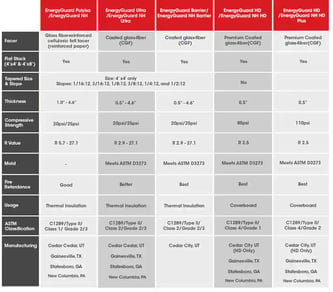
Roofs are renowned for being the strong, reliable protectors of our homes. Have you ever thought about the components that make them that way, though? Each roof element plays a role in its functions, and one of those materials is often polyisocyanurate (or ISO for short.)
Now, let me tell you, polyisocyanurate might sound like a mouthful, but it's one of the secret weapons of roofing. It's like a behind-the-scenes hero, quietly doing its thing to keep our homes comfy and secure. Here at RoofCrafters, we've repaired and replaced insulated roofing systems since 1993. We know that roof materials, especially the undercover ones, are tough to memorize, but that's why we're here- to break them down for you.
Grab your work boots and get ready to explore the world of polyisocyanurate in roofing. It might not wear a cape, but it's an absolute game-changer when it comes to keeping our homes strong, comfy, and protected year-round. By the time you finish reading, you'll know the essentials about polyiso to help you determine if it's a good fit for you and your home. Let's hop right in!
Polyiso-what? The Material Explained
Polyisocyanurate (ISO) is a type of rigid foam insulation material widely used in roofing systems for its excellent thermal performance and versatility. It's a closed-cell insulation board made from a polyisocyanurate foam core sandwiched between two facers, typically made of fiberglass, felt, or coated paper.
One of the primary reasons polyisocyanurate is popular in roofing is its impressive insulating properties. It has a high R-value per inch, which means it provides efficient thermal resistance compared to other insulation materials. This helps in keeping buildings cooler in summer and warmer in winter, reducing energy consumption for heating and cooling, thus making it an eco-friendly choice.

Polyiso's composition and structure contribute to its advantages. Being a closed-cell foam, it effectively resists moisture penetration, making it suitable for various roofing applications. Its closed-cell nature also prevents water vapor from passing through, minimizing the risk of condensation within the roofing system, which can cause structural issues and reduce the insulation's effectiveness.
In roofing, polyisocyanurate insulation boards are commonly installed above or below the roof deck, providing a continuous thermal barrier. They are compatible with various roofing membranes, such as single-ply membranes or built-up roofing systems. Polyiso boards can be mechanically fastened, adhered to, or installed using a ballast system, offering flexibility in installation methods.
Polyisocyanurate boards are also lightweight yet durable, allowing for ease of handling during installation while providing structural strength and stability to the roofing system. Their resistance to fire, high compressive strength, and dimensional stability under varying temperature conditions further enhance their suitability for roofing purposes.
Keep in mind that while polyisocyanurate has numerous benefits, it's essential to ensure proper installation and compatibility with other roofing materials to maximize its performance and longevity. Understanding local building codes and manufacturer guidelines is also crucial for the correct application of polyisocyanurate insulation in roofing systems, ensuring optimal thermal efficiency and durability for the building.
Are Materials like Polyisocyanurate Essential in Roofing?
Materials like polyisocyanurate insulation play a significant role in roofing systems and are often considered essential due to their valuable contributions to the performance, energy efficiency, and durability of buildings. Let's look at a quick breakdown of every benefit they offer:
Thermal Insulation: Insulation materials like polyisocyanurate are crucial in roofing systems for providing thermal insulation. They help maintain a comfortable indoor temperature by minimizing heat transfer and reducing the need for excessive heating or cooling. This directly impacts energy consumption and cost, making them essential for energy-efficient buildings.
Moisture Control: Proper insulation helps manage moisture within the roofing system. Polyiso's closed-cell structure prevents moisture ingress and limits condensation, thereby reducing the risk of damage to the roof structure and maintaining the insulation's effectiveness over time. This moisture control capability is vital for preventing mold growth, structural deterioration, and potential damage to the building's interior.

Long-Term Performance: Insulation materials contribute to the longevity and durability of roofing systems. They help protect the roof structure from extreme temperature variations, reducing thermal stress on the roof components and extending their lifespan. Polyisocyanurate's dimensional stability and resistance to degradation ensure its effectiveness in providing continuous thermal insulation throughout the building's life cycle.
Building Energy Codes and Standards: In many regions, compliance with building energy codes and standards necessitates the use of efficient insulation materials like polyiso in roofing systems. These regulations aim to promote energy efficiency, reduce greenhouse gas emissions, and improve the overall environmental impact of buildings. Therefore, such materials become essential for meeting these stringent requirements and ensuring building compliance.
Environmental Impact and Sustainability: Insulation materials also contribute to the sustainability of buildings. Using efficient materials like polyisocyanurate helps reduce energy consumption, thereby lowering carbon emissions associated with heating and cooling. Additionally, polyiso insulation boards often contain recycled content, contributing to sustainable building practices.

All in all, materials like polyisocyanurate in roofing systems are considered essential due to their significant impact on energy efficiency, moisture control, durability, and compliance with building codes. They play a crucial role in creating comfortable, sustainable, and long-lasting buildings while minimizing energy costs and environmental impact.
Will My Roof Benefit from Polyisocyanurate?
Wrapping up, polyisocyanurate – that's kind of a big word, isn't it? But it's an incredibly useful material for both residential and commercial roofing systems! It's like the cozy blanket that keeps our homes and buildings just right- warm in winter and cool in summer. This insulation stuff might not be the star of the show, but it's definitely one of the unsung heroes of our roofs.
While we're on the subject of roof materials, why don't you take a peep over at our learning center? It's full of priceless information about everything you should know regarding your roof system and how to take care of it. You may learn a thing or two!
At RoofCrafters, we want you to know that the roof replacement of your dreams is only a number dial away. If you need to do a little more research before you make any commitments, however, feel free to do so! No matter if your roofing concern is big or small, we have you covered from the beginning to the very end of the process. If you're ready to get in touch with one of our awesome representatives, head over to our contact page.
My name is Kevin Mills, and I am the lead estimator for RoofCrafters’ Tampa division. I’m originally from Michigan, and I enjoy hunting, fishing, and spending any free time outdoors. What I’m most passionate about, though, is helping business owners and homeowners alike achieve their roofing goals, all while providing a seamless customer journey.





